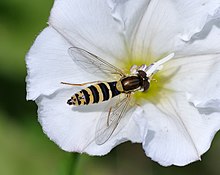Common long-bellied hover fly
| Common long-bellied hover fly | ||||||||||||
|---|---|---|---|---|---|---|---|---|---|---|---|---|

Common long-bellied hover fly ( Sphaerophoria scripta ), male |
||||||||||||
| Systematics | ||||||||||||
|
||||||||||||
| Scientific name | ||||||||||||
| Sphaerophoria scripta | ||||||||||||
| ( Linnaeus , 1758) |
The sphaerophoria scripta ( Sphaerophoria scripta ) is an insect of the family of hoverflies (Syrphidae). It is also known as the common long-bellied hover fly or common pen hover fly .
features
The flies reach a body length of 9 to 12 millimeters and have an elongated, very slender body. The face is colored shiny yellow and has a dark hump in the middle. The mesonotum is black and has yellow stripes on the sides that extend to the label. This is dull yellow in color and hairy yellow, the legs are yellow. The wings are transparent, the pterostigma , like the holders and the wing scales, are yellow. The dark abdomen has wide yellow bands on the third to fourth segments, with these black and yellow markings being variable. On the fourth tergite of the male there is a pair of yellow spots in front. The fifth tergite has a black longitudinal line in the middle and a pair of black spots on the sides, both at the base and at the back. The female, on the other hand, has a brown-black central spot at the base of the sixth tergite and two spots on the rear edge. The seventh tergite is red-brown in color and yellow on the sides. The females can only be distinguished from other species of the genus Sphaerophoria with the help of a magnifying glass.
Occurrence
The common long-bellied hover fly occurs in the Holarctic and Oriental . It is the most common species of the genus Sphaerophoria , which can be found from March to October in almost all biotopes and especially in open terrain. It is one of the migratory hoverfly species.
Way of life
The animals feed on pollen and nectar , can be found on the flowers of many different plant species and, due to their elongated body, can also visit tubular flowers. The females lay up to 1000 eggs in aphid colonies , the larvae then feed on aphids. The larva overwinters and pupates in spring.
swell
- Olaf Bastian: Hoverflies. Identification key for the hoverflies (Diptera, Syrphidae) of Germany and the Netherlands ; Neue Brehm-Bücherei Volume 576, Westarp Sciences, 1994, ISBN 3-894-32469-4
- G. Bothe: Schwebfliegen , German Youth Association for Nature Observation, 8th edition, Hamburg, 1996, ISBN 3-923-37607-3
- Joachim Haupt, Hiroko Haupt: Flies and mosquitoes: observation, way of life , Naturbuch Verlag, Augsburg 2001, ISBN 3-894-40278-4
- Kurt Kormann: Hover flies and bladder-head flies of Central Europe , Fauna-Verlag, Nottuln, 2002, ISBN 3-935-98029-9
- Kurt Kormann: Hoverflies of Central Europe. Occurrence. Determination. Description. Color atlas. , Ecomed Verlag Landsberg, 1998, ISBN 3-609-65890-8
- Gerd Röder: Biology of hoverflies in Germany (Diptera, Syrphidae). , Kelter-Weiler, 1990, ISBN 3-980-13812-7
Web links
- Fauna Europaea systematics

